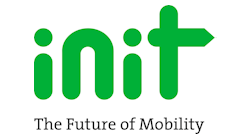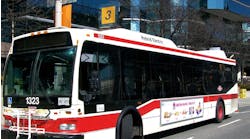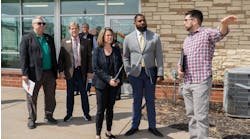According to the Pinellas County Metropolitan Planning Organization, Pinellas County is expected to grow by more than 200,000 people and 148,000 jobs in the next 25 years. Part of a peninsula, it is bound by water on the west by the Gulf of Mexico and on the south and east by Tampa Bay.
Pinellas Suncoast Transit Authority (PSTA) Chief Executive Officer Brad Miller described some of the things that make the area unique. There are very few white-collar jobs, little downtown commuting and a higher density throughout the area.
Pinellas County is fully built out and Miller said it is the densest county in the state of Florida. “There’s no more room to sprawl out in Pinellas … there’s hardly any undeveloped land in the county.”
This helps keep ridership high, relative to the amount of service they provide as the density lends itself to some ideal transit corridors with a mix of retail, business and medical facilities.
Greenlight Pinellas
Greenlight Pinellas was a transit referendum that would have been a 1-cent sales tax to expand transit in Pinellas County, bringing in about $130 million a year for PSTA. On November 4, 2014, 62 percent of the voters voted no on the referendum.
To plan for Greenlight Pinellas, Miller said he worked with the Center for Transportation Excellence (CFTE) and gathered research on transit referendums.
PSTA staff went out and created a broad coalition with many different community groups and stakeholders, the Sierra Club, the business community, and area chambers, but in the end, it was PSTA staff leading Greenlight Pinellas. One thing Miller said they would do differently if they were to do it over, is to have another group in the community lead it, to be the face of Greenlight Pinellas.
“Whether or not that group exists in Pinellas County, I don’t know,” said Miller. “But where it’s been successful, it has not been led so directly by the transit authority. It’s either been a single political entity, like a strong mayor, or a citizen’s group. I think that’s what we needed.”
When the results for Greenlight came in, it was shocking to staff because the polls never indicated that they were going to lose by as much as they did. “We thought it was going to be very close and were still very hopeful until the poll results came in,” Miller said. “It was very shocking.”
They had a press release out the next day, Cyndi Raskin-Schmitt, director of communications, said. She said it was important to tell the community, “PSTA is still here, we’re still providing service, we still have an important role in the community and we’re going to keep working for the people who ride the bus.”
Leading up to Greenlight, Chief Development Officer Cassandra Ecker Borchers said they had talked to staff about planning for a failure but saw them deflate. “We couldn’t have people deflate. We knew what we had to do.”
They decided they would plan three financing scenarios and develop the concepts, but not the details.
The day following the election, Raskin-Schmitt said, “We all came in; Brad had everyone come together. It was pretty somber.”
Miller said it was key for him and the organization to look forward and be positive about what had been accomplished.
Looking at the positive, he said public transportation is a much higher profile issue than it was pre-Greenlight.
Ecker Borchers said, “We told people we have lots more to do.”
“It definitely wasn’t go back to the status quo,” agreed Raskin-Schmitt. “And of course you’re going to be disappointed; it was 2 years all in.”
The reality they faced was cutting back on services and it took about 6 to 8 months to get to that point. Raskin-Schmitt said, “We didn’t pull back as quickly as some people thought we should. Some of the big anti-transit people were like, ‘Well, it’s November 5th. Why haven’t you cut all the service? The referendum failed yesterday.’”
Ecker Borhcers said it was a really tough position to be in. “I wish we would have cut sooner,” she said, when it was fresh on people’s minds. “I think if we had done it sooner they would have said, “I told you this was going to happen, sorry.”
They were even seeing on social media, if people were posting complaining of services not running late enough or often enough, other riders will jump in and ask, “Well where were you? Did you vote for it?” explained Raskin-Schmitt.
Path Forward
The new strategic plan, Path Forward, was adopted to set the priorities of the organization. The plan for Greenlight was a well-thought-out plan that was tied to land use and will still be the organization’s vision but instead of the silver-bullet funding of Greenlight, they’re planning it with incremental progress.
“It lays a very specific foundation that our focus — our No. 1 focus — is on providing a customer-oriented public transportation system and then building on that,” Miller said of Path Forward.
Part of the Greenlight plan had been to do a community bus plan with a grid network, replacing the hub-and-spoke-type system it had become into each of the shopping malls as they developed in the 1970s and 1980s.
PSTA is focusing on developing a grid network across the county with high-frequency core routes, and some might be bus rapid transit (BRT) or express routes to key destinations.
“On Valentine’s Day we are giving this Valentine’s Day present to the city of St. Petersburg by moving the buses away from ringing around this park called Williams Park,” explained Miller.
Raskin-Schmitt said they will be going in the night of January 30th to take all of the bus shelters out so when people come back on the 31st, it will be completely different. They will put up sandwich boards and people will still use those stops until the 13th. As of the 14th, none of those buses will be going there anymore; they’ll all be rerouted onto the grid in downtown.
Senior Planner Heather Sobush said they have been developing a comprehensive set of changes to modify the system under different financial scenarios: one if the referendum had passed, one with the current revenues and one if they could do anything to make the system great.
“Now we’re kind of at that point of working with our existing revenues and looking for additional revenues,” she said.
“We had it in phases. Phase 1 we did a few tweaks with our under-performing services in October. Phase 2 is doing a grid network in downtown St. Petersburg, which is the most dense area in Pinellas county in terms of population, employment and in the way our transit service is provided.
“Phase 3 we’re currently in the process of planning — looking at the entire network.”
Phase 3 involves additional public outreach, analysis of every route and looking at how they can move people more efficiently.
In addition to the system redesign of its routes, PSTA is on the path of implementing additional premium projects. Sobush said it’s important to show a community what good transit service is. “When people start seeing what good services looks like, they get it. But it’s hard to get a truly good service to have that community support you.”
One of the premium services is the Central Avenue Bus Rapid Transit line. Sobush said they are tentatively getting money from the state to do a project development study to move that next step forward, asking the Federal Transit Administration to enter into project development.
The corridor will be in St. Petersburg, from downtown over to the Gulf of Mexico, PSTA’s highest ridership corridor.
They are proposing to have a dedicated fleet with off-board fare payment, station-like stops and a dedicated lane for at least a good portion of the corridor. Miller said they anticipate it will be a system similar to the Silver Line BRT in Grand Rapids, Michigan.
PSTA is also working on an express bus service from the airport in Tampa to Clearwater beach, one of the premium tourist destinations.
While funding hasn’t been identified yet, they’re working with the state to do that and do it properly.
The Latest Technology Improves Efficiencies
While they receive a lot of calls from their peers about the Greenlight plan and referendum, Miller said they also get a lot of calls about the real-time bus information program, powered by Clever Devices.
Sr. Project Director – Technology Walt Lenz said they did system acceptance in 2012 and that it has been, “one of our more successful projects by leaps and bounds.”
PSTA wanted to give riders all the options of accessing real-time information: an infoline with interactive voice response (IVR) with automated departure times, QR codes provide departure times, automatic email and text alerts, texting for departure information, and many of the busiest transfer locations have electronic signs.
Raskin-Schmitt explained that texting is not the most economical option, as you pay for every text — incoming and outgoing. However, it was cheaper on the front end than developing their own app.
They bought all the modules at once, instead of trying to add on and while riders use all of the platforms, texting gets the most use, by far. “We did over 5 million last year,” said Raskin-Schmitt.
PSTA has Wi-Fi on all of the buses. Lenz said they have a router on the bus, it grabs a cellular signal and it dispenses it through the bus.
When asked about whether or not there’s a landing page, Lenz said they didn’t do that as they’ve heard of some looping problems, where people can’t get away from the page. Instead, they put their disclaimers physically on the bus.
When they started Wi-Fi they did a pilot project on 10 buses with Verizon, which worked well but when they got the bill it was very expensive. They reached out to AT&T, which provided an unlimited plan.
They initially tested AT&T on 10 buses and didn’t see any difference on performance. They’ve now had AT&T more than a year.
Lenz said if they could wind back the clock and do things differently, maybe they would bring these technologies on in combo and get one cellular provider. The Wi-Fi is with AT&T, the real-time is on Sprint and the PSTA cellphones are Verizon.
“The problem is they’re proprietary, so if AT&T came and said, ‘Hey, we can give you a great deal for your bus AVL side,’ we would say thanks but no thanks because then we would have to buy all new equipment.
“Not even so much the modems, but the equipment we have on there have modems built into them, so we would have to get a new type of router or modem in there.
“What we should have done, is there are routers out there which can handle multiple peripherals connected into them. If I had to take the clock back, I would have gotten a different type of router which allowed all this technology.
“Now it’s open architecture, which you can almost pick the cellular provider, like your phones.”
Regional Fare Collection
The 7-county region is working on a regional fare collection project, with PSTA and Hillsborough Area Regional Transit Authority (HART) being the largest of the agencies and HART handling the procurement.
HART had LTK Engineering Services as the consulting firm, though the contract has just expired and HART has to go back out and re-procure a consultant. Lenz said, “We’re crossing our fingers we get them back because we have our history with them. We want the consultant to take it to the very end.” As of the time of interview, the project is looking to make HART’s February board meeting for board approval. They have chosen to go with Init Innovations in Transportation Inc., for the technology.
They were looking for an account-based system and Lenz said. “They all pretty much offer the same type of software or hardware, so let’s look at the company over all and what they’ve done.”
Raskin-Schmitt said because they were looking at a multi-agency project, they wanted a firm that understood the intricacies of a regional project and being able to customize those to fit.
Lenz added, “There was some angst because Init’s big in Europe but just coming over to America on the smart card, not the GPS, but we liked what we had seen with them. We thought they brought a really good product and the more we’re dealing with them, the happier we’re getting that we went that route.”
Lenz explained why they wanted an account-based system. “It’s instantaneous gratification,” he said. “Riders can put money on a card on the Web portal, then go out on to the bus and go.”
It also allows a wider variety of media, such as debit cards and charge cards and near-field communication (NFC) on smartphones.
They’ve been talking about implementation of the new system and they’re thinking about getting something out to the public quick in a low-end visual app. Init has been working with The Brigade, out of Portland, Oregon, to develop something they can get out and once that’s up and working well, they will start moving on to the complex side and developing a more robust application.
“There’ll probably be some intense pilot programs,” explained Lenz. “This is not a really complex hardware install; the back office is the complexity.
“When we went to a technology fare seminar by APTA [American Public Transportation Association] back in Orlando, they [Chicago] did a presentation in one of the breakout sessions and said, ‘Here’s everything that goes wrong.’
“You learn a lot from that. One of the things we discovered is the expectations of the product. Make sure you really have it working before you put it out there.” He added, “We’re going to take a very slow process on that.”
With a lot of tourists riding the buses and trolleys, it won’t be as important to get the smart card out to a set group of commuters like it might be in another city, said Miller. “It’s using your phone as soon as you arrive at a hotel on Clearwater beach to download the app and then you pay for your 3-day bus pass which will cover you for your weekend trip … and then you can ride by tapping on and off with your phone.”
The marketing directors of the participating agencies are determining what the name of this will be, how it will be marketed and ensuring they all have money in their budgets for marketing it.
Lenz said, “This system is going to be built on that you can use debit cards, credit cards; we’re taking it all the way we can take it.
“When you factor that in, giving the customer a more seamless way to ride the buses within the region, one card fits all, the amenity of the real-time information and just the icing on the cake — Wi-Fi on the buses, why drive?”
Fleet Efficiencies
“I think every transit system is unique,” said Miller. “And PSTA, even before I started, I researched it and knew from the day I got here it is an incredibly well-run bus system.”
He stressed its efficiencies and said PSTA is the lowest cost system in its benchmarking group. The paratransit operations has been contracted out to taxi cabs and local private van operators.
They also run the fixed-route buses a high number of miles compared to other systems. At one point there had been an earmark which allowed them to purchase a lot of buses at one time, and current funding doesn’t allow for replacement of that many at a time.
Deputy Director of Fleet Operation Joseph Cheney Jr. came to PSTA from the Massachusetts Bay Transportation Authority and said the AVM health monitoring system from Clever Devices has been a big help in maintaining the fleet.
“It gives us notifications when things go wrong and we can dispatch someone out; it’s relatively efficient.” He added, “The next version of the AVM is going to allow diagnostics on the engines … I can sit at my computer and in real time, dial in to that bus and diagnose and test while the bus is being driven. That will probably be the best thing since sliced bread.”
Miller said while it was always a nicely run system, the challenge was it wasn’t connected to the community it served, which is why he was brought on board. While it was something that needed a new focus, he said now, he thinks it’s one of the best things they do.
“There has never been a greater outreach effort in the Tampa region than we did for Greenlight Pinellas,” said Miller.
Social Essentials
At the outset of Greenlight, an outside marketing firm along with PSTA’s marketing team felt it was important for key stakeholders out in the community to know who CEO Brad Miller was and to help in leading PSTA’s effort.
There was a bit of apprehension and a lot of discussion to ensure it would prove beneficial. Cyndi Raskin-Schmitt, director of communications, said they weren’t as concerned about what Miller would say, but about what other people would say.
“People were already being mean with Greenlight,” she explained. “If they were tweeting directly at him, would people be nasty?”
It was part of a specific effort to humanize PSTA. The CEO is a regular person that takes his kids on the bus, goes on vacation, posts pictures of himself riding the subway. “We’re not a big, scary government agency,” Raskin-Schmitt said. “We’re human beings and we are people here.”
The hardest part for him initially was “finding his social media voice,” Miller said. He started on Twitter and was forwarding other people’s tweets but was told he needed to find his own voice. Since then, he said, it’s evolved.
He’s on Facebook and Twitter and said all of his elected officials are engaged in those platforms, as well as the local news media. “I think it is obviously a key way that everybody, especially key stakeholders, my board members and others in the community, communicate and know what’s going on.”
About being on social media, Miller said, “I have to be careful about it, but it’s been great.
“It’s been a helpful way to communicate with board members … sometimes you have a better understanding of what each other’s doing over Facebook.”
People are often concerned about the potential harm social media can quickly inflict. Miller relayed one experience.
The union at PSTA was very positive about Greenlight Pinellas, as they saw they would be benefitting from it. They were more outspoken about it on their Facebook page, sometimes posting negative things about the opposition.
“I felt like I always try to ‘like’ the union’s things, which is important for me,” Miller said. One day he received a call from a reporter asking about a post he had liked, which was against a local restaurant. The union had a post telling people not to go to the restaurant because the opposition group had all their meetings there and the restaurant was probably anti-Greenlight.
“I ‘unliked’ it and learned my lesson,” said Miller. “It’s like the old saying, don’t do anything you wouldn’t want to be on the front page of the paper.”
Transportation Manager
The impact ride-hailing services have on public transportation is a hot topic and while some view it as a threat, others find the opportunity.
There was a neighborhood where PSTA discontinued service and another neighborhood with limited service. To help people in that zone, PSTA has partnered with Uber and a taxi cab company for a pilot project to help riders get to a PSTA bus stop.
If you are in the zone, are going to one of the two bus stops, the apps for the companies has a PSTA slider that shows up on the screen. You slide it over and PSTA covers half your cost, up to $3.00, to get you to the bus stop.
The bus stops in both zones are retail stops and Miller said theoretically, someone could take Uber to go shopping and may never take the bus. However, the parameters are set petty closely and even if someone were to do that, he said it’s still a lower cost than if they were running a bus for them to get there.
“It shows that we’re a transportation provider, meeting that first-mile, last-mile piece and providing connections,” said Miller. “It shows that PSTA is looking to be innovative and to come up with the best solution, not the same solution.”
The cab companies in the area are very opposed to Uber, Miller said, and there are currently debates on it at the state capital.
“We contract out already with cabs for our paratransit,” he continued. “We’re for a level playing field; it doesn’t have to be Uber.
“Hopefully, I think us showing transit, cabs, Uber — it’s all transportation, may soften the debate a little. It’s coming, so we might as well deal with it.”
Growing Up Transit
Miller grew up in transportation with a father that was a professor of transportation at Penn State. He said of growing up, his family would go over to the bus garage after dinner to check out new buses, he had a farebox in his bedroom when he was a kid and he was a bus for Halloween not one time, but twice.
He attended the College of William & Mary in Virginia and got his Master’s in Public Education in Syracuse. He got an internship with a new commuter rail at the time, the Virginia Railway Express (VRE) working for the Potomac and Rappahannock Transportation Commission (PRTC).
A month or so after starting, the planner quit and Miller got hired on as a planner.
His first week of the job he was sent out to the platform to tell the 300 people standing there that the train wasn’t coming because it broke down. Miller said, “To be involved with a transit agency where they were yelling at me about the train … it wasn’t the most awesome thing, but it was good.
“These people reallyl needed it. They weren’t going to be able to get to their jobs in D.C. without it; this is their livelihood.”
He worked for the VRE and PRTC for 8 years and as it was a relatively small transit system, got involved in all aspects. Following that he had the opportunity to work at Charlotte Area Transit System (CATS) with Ron Tober when they had just passed a new sales tax. In that time they were starting to implement the new light rail and expanding the bus network.
After 6 years at CATS, Miller said he was contacted by a recruiter and asked if he would be interested in becoming a head of a transit system in Des Moines, IA. Miller said, “I was like, ‘No.’
“It’s not really known as the hotbed of urban mass transit.” He continued, “Then my wife and I went out there for the interview and it’s a really, awesome, dense downtown … It’s a very urban place, a commuter-oriented bus system there and it was great.”
While everything was great about Des Moines, Miller said, it was 1,000 miles away from any family. The position at PSTA opened, he called about it and has been at PSTA for 4-1/2 years now.
“I love all of it,” he said of working in public transportation. Though his favorite part, he said, is the noticeable impact it has on people and the community.





